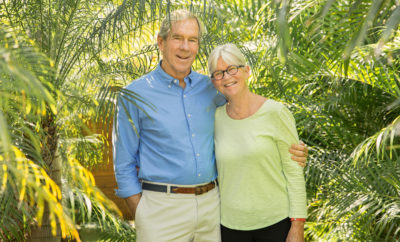
Feature
Saving Land For Today & Tomorrow
Conservation Foundation of the Gulf Coast
by Ryan G. Van Cleave
It’s the biggest success story in the recent history of Conservation Foundation of the Gulf Coast — the $3 million acquisition of a conservation easement protecting Triangle Ranch, a 1,143-acre property in the upper part of the Myakka River in Manatee County. It took three years for this to come to fruition and the last piece of the financial challenge in making this purchase happen came from Bradenton conservationist, Elizabeth Moore, in October 2016 when she provided over $3 million to acquire the property and contribute toward the conservation easement. Along with funding by the William G. and Marie Selby Foundation, the Morton Spapperi Family Foundation, and SWFWMD (the Southwest Florida Water Management District), this support by Elizabeth Moore took Conservation Foundation to the financial finish line. Conservation Foundation’s hope is that creating a permanent conservation easement on Triangle Ranch is the first action in a domino chain of environmental goodness that’s to come.
Originally, this Old Florida property was known as the Carlton Triangle Ranch because it was owned by the Carltons, a prominent 1800s farming family in Myakka who used it primarily as a cattle ranch. The triangle name came from their distinctive cattle brand. During the 1950s, dikes were built along the 3 miles of the Myakka River that flows through the property, separating it from its surrounding floodplains and wetlands. Unfortunately, this has created significant problems with the natural timing and amount of water flowing between the river and the Tatum Sawgrass marsh. The Myakka River in Manatee County is not designated as a state Wild and Scenic River as it is in Sarasota County because so much of the land — like what has happened at Triangle Ranch over the decades — has been altered from its natural habitat to ranchland.
Now that Triangle Ranch is owned by Elizabeth Moore, there will still be ranching and compatible recreation that provides economic opportunities for the area. The land, though, will no longer be developed. Moore will manage the land subject to the perpetual restrictions of the SWFWMD-held conservation easement. One of the motivations for Moore to partner in this deal was the opportunity to magnify her charitable dollars. Thanks to partnerships and matching grants, she hopes to further leverage her funds to continue making a difference in protecting and restoring this part of the upper Myakka River.
The conservation easement on Triangle Ranch provides the chance to restore the connection between the Myakka River and Tatum Sawgrass marsh, which is one of four depression marshes — and the least protected — in the Myakka River valley. Along with Flatford Swamp, and Upper and Lower Myakka Lakes, these marshes greatly contribute to flood protection and biodiversity. Many people don’t realize it, but the tower at the Crowley Nature Center looks right down on the Tatum Sawgrass marsh at Triangle Ranch.
The 1,143 acres of Triangle Ranch that are now protected, link and adjoin over 110,000 acres of already protected land creating a sanctuary for wildlife. Well over 120 species of birds and an array of animals call this area home or use it on their migration path, including Florida panthers and the threatened crested caracara, as well as numerous wading birds, song birds, migratory birds, and raptors. There are fewer than 100 Florida panthers left in the wild so preserving and linking more of their habitat is a huge coup for Conservation Foundation.
Another reason the Triangle Ranch acquisition is so important — beyond simply adding 1,000+ acres to the 8,000 acres they’ve already protected — has to do with water quality. Three miles of the Myakka River winds through Triangle Ranch, and this area is upstream, so the water quality there impacts everything downstream.
Conservation Foundation’s Director of Land Protection Debi Osborne explains that “it’s important not just to look at the Myakka River, but also at all the tributaries that flow into it. Taking care of the entire watershed, from its headwaters in Flatford Swamp to where it enters the Charlotte Harbor estuary and into the Gulf of Mexico is a top priority for Conservation Foundation.” Indeed, it’s a priority for many local and regional organizations and agencies.
Osborne explains that “using that [the acquisition of Triangle Ranch] as our initial foothold into the upper part of the Myakka is really a leveraging opportunity.” That opportunity comes from bringing in additional outside funding sources to help conserve additional properties, such as SWFWMD’s assistance in this purchase. Local, regional, and federal land acquisition dollars are limited so it typically takes multiple funding sources, public and private dollars, to protect high priority properties. Osborne admits that “getting public dollars to get the job done is our constant struggle.” Conservation Foundation is using the success of the Triangle Ranch conservation easement to apply for new federal grants to continue to acquire key adjoining properties.
Conservation Foundation is not resting on the laurels of their recent success, though. They are quite interested in Murphy Marsh, a cattle ranch and hunt club that links Triangle Ranch and 1,200 acres of protected property to the north. It’s the last remaining unprotected portion of Tatum Sawgrass marsh — a unique area that needs help now. In the 1950s and 60s, much of that marsh was drained, ditched, and diked to create areas for row cropping. And it didn’t work. Those actions ultimately cut the Myakka River off and the water stopped feeding it. “There are landowners in that area who are willing to help by protecting their land and allowing restoration,” says Osborne,” but we need additional dollars to get this done, and we’re working with time limits. The environmental clock is ticking.” To that end, Conservation Foundation is always looking to put together creative partnerships to help conserve more land.
There are other locations on their wish list too, well beyond those in upper Myakka. There’s a critical 5,774-acre property in North Port called Orange Hammock Ranch that Osborne notes is “the largest undeveloped block of land in Sarasota County that remains in its native habitat. It has imperiled dry prairie — very rare!” Protecting Orange Hammock Ranch will also help protect the City of North Port’s drinking water. Plus Conservation Foundation is looking at opportunities in the Charlotte Harbor estuary itself, including a 58-acre peninsula at the confluence of East and West Coral Creek.
With so many worthy projects before them, a recent three-year Healthy Watershed Consortium Grant (funded by the U.S. Endowment for Forestry and Communities and EPA) received by Conservation Foundation is making a difference. This grant is designed to accelerate the protection of healthy watersheds, and the Myakka River Watershed is 1 of only 9 watersheds nationwide selected for this funding.
Instead of needing to chase small grants and opportunities to fund their day-to-day operations, Conservation Foundation can use staff resources more wisely. Big land acquisition grants are very competitive and difficult to get, Osborne notes. But the odds of landing one are much higher when Conservation Foundation land protection staff can focus on facilitating collaborative partnerships, and use the success of Triangle as a match to get additional funding for other properties along the river.
Osborne says that one of her greatest joys is working with landowners who love their land and simply want to find a way to protect it and keep it for future generations. With a bit of financial luck and community backing, Conservation Foundation will create more success stories that enrich our communities, assist landowners, and create future opportunities for more much-needed environmental work to come.
FOR MORE INFORMATION
on Conservation Foundation of the Gulf Coast, please visit ConservationFoundation.com call 941.918.2100.







You must be logged in to post a comment Login